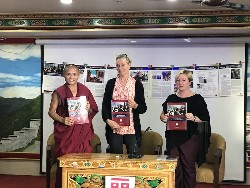Tibetet Segítő Társaság Sambhala Tibet Központ
Tibet Support Association Sambhala Tibet Center
székhely / telephely H-Budapest I. Attila út 123..
(00-36) 70 431 9343 (00-36)70 944 0260 (06-1)782 7721
sambhala@tibet.hu www.tibet.hu tibetpress.info
Facebook/Sambhala Tibet Központ Facebook/Tibett Segítő Társaság
MagnetBank/ 16200010-00110240
IBAN/HU94 16200010 00110240 00000000 SWIFT/HBWEHUHB
(1%) adószám/ 18061347-1-41
nyitva tartás/hétköznap 12.00-20.00 hétvégén előadás függő
» Retro» Tibeti művészet» Interjú» Levelek» Tibet Press» Tibet Press English» Dharma Press» Human Rights» Világ» Kína» Magyar» Ujgur» Belső-Mongólia » KőrösiCsoma» Élettér» Határozatok» Nyilatkozatok» tibeti művészet» lapszemle.hu» thetibetpost.com» eastinfo.hu» rangzen.net» ChoegyalTenzin» tibet.net» phayul.com» DalaiLama.com» vilaghelyzete.blogspot.com» Videók» Linkek» TibetiHírek» Szerkesztőség
Az egykori politikai foglyok csoprtjának volt vezetője: Az 1987-es tüntetések tüze még mindig ég Tibetben
2017. október 10./Phayul.com/TibetPress
Jelenleg csak angolul olvasható. Magyarul később.
eredeti cikk
By Tenzin Monlam DHARAMSHALA, October 10: The fire of 1987 uprising is still burning inside Tibet and the flame has not diminished, said former president of the GuChuSum Movement Ngawang Woebar at the launch of Tibet Watch’s report on the uprising titled, ‘30 years of Resistance: The Legacy of the 1987 Lhasa Protest’ at Norbu House in McLeod Ganj.
DHARAMSHALA, October 10: The fire of 1987 uprising is still burning inside Tibet and the flame has not diminished, said former president of the GuChuSum Movement Ngawang Woebar at the launch of Tibet Watch’s report on the uprising titled, ‘30 years of Resistance: The Legacy of the 1987 Lhasa Protest’ at Norbu House in McLeod Ganj.
The organization that monitors, advocates and carries out research on human rights in Tibet also organized a panel discussion on the uprisings in Tibet from 1987 to 1989. Christa Meindersma, who was shot during the protest in Lhasa on December 10, 1988, took part in the discussion along with Ngawang.
Ngawang, who was amongst the group of 21 monks that began the protest on September 27, 1987, said that the protest was planned in two-three days and was decided that it would be a peaceful demonstration.
Recalling the day of the protest, he said, “We managed three rounds of Barkhor, narrow streets and a public square located around Jokhang Temple in Lhasa and had plan to march into the government building, if possible. However, most importantly we had pledged not to retaliate.”
Known as the largest demonstration since 1959 uprising in Lhasa, it sparked a wave of protests in the following days and many Tibetans were either killed or incarcerated for the acts of dissent.
“I think the seed of Tibet’s struggle in the youths was sowed during the 1987 uprising. For the past 30 years, it has fueled the younger generations’ love and responsibility towards Tibetan struggle and regards towards Tibetan cultural heritage,” said Ngawang, who came into exile in 1991.
As shown in the report, Christa Meindersma shared her story of that day when she thought she would either be imprisoned or die. She said, “Seeing the report and the photos parachuted me back to that day. It is very emotional to see these pictures of those who were there and went through the same thing, at least on that day.”
She described how she managed through the pain and bullets flying across her face as Chinese troops open fired at the Tibetan protestors near Jokhang. An unknown foreigner and a Tibetan woman helped her to her hotel and at the hospital she went through hours of interrogation. Christa was kept under house arrest for a week and her passport was confiscated as well.
Thanking the two speakers, Eleanor Byrne-Rosengren, Director of Free Tibet (research partner of Tibet Watch), said that it was these protests that got her attention towards Tibetan struggle.
The report contains some unseen photographs from the protests. The main goal behind the report is to honor the memories of those who have made sacrifices for Tibet and also to remind the new generation of what happened.
